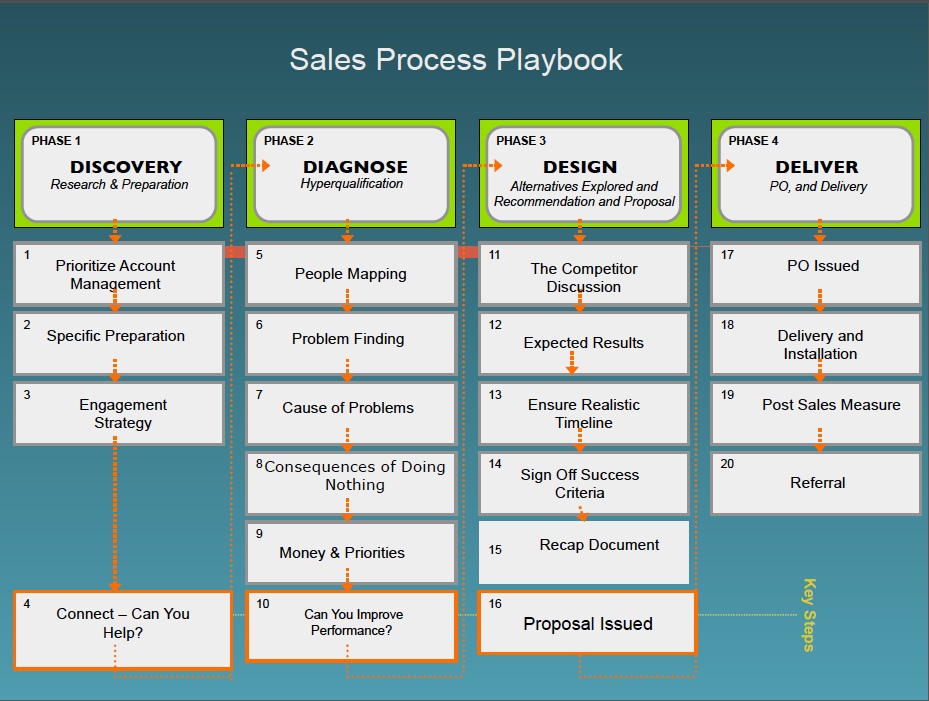If you are in a hyper-growth state, growing at 25% to 250% per annum, you might be tempted to ignore the need for a solid sales process. Why bother? Life is good. Well in my experience it is essential you understand the “Why” you are growing. The internet rocket took a lot of very average managers to instant success. Repeating that success has been as elusive as the Yankees winning a baseball game or the Patriots catching a ball. Processes smartly executed deliver a rich dashboard of insight and learning. Part three of this series looks at a world class sales process and how to implement it into your business.
Sales Process: A CRM system or a set of smart sales moves is not a sales process. A sales process defines stages that opportunities need to pass through to become closed deals. Great technology can transform the productivity of any process. Just look at what spreadsheets did for financial modeling. But you need to know how to capitalize on the technology. Spreadsheets need a process. You need to be clear on your input fields, you need to be clear on what your graphs and tables are demonstrating. In the same vein Salesforce is a great technology. ACT/Sage is pretty good as well. But they will all fail without a world-class sales process.
At TPP we embed the following sales process playbook in our clients. The process has evolved from 15 years of M&A deals, lessons learned from six turnarounds, the insight from Sandler’s system and the process maps of Jeff Thull’s Prime Process.
The thing to realize about a great sales process is that it’s really a great negotiation process. You only arrive at a great place on say page 20 if you’ve worked hard on pages one to 19. That means you must stop premature pitching, premature pricing and premature proposal writing. I’ll focus my guidelines on the business to business world.
Here is a one slide picture of the process.
Discovery
Whether a sales prospect has called you or whether you are reaching out to engage with a prospect, all deals start in a Discovery phase.
Discovery forces a mindset of curiosity. It demands that the sales professional prioritizes his work. Not all sales leads are born equal. There are no excuses these days for not doing your homework on a prospect. The Discovery phase answers the question: Where do I spend my time this week? It demands an Engagement Strategy (how you believe you can improve the prospect’s performance), no matter how naive, how superficial. It forces the sales professional to think like an entrepreneur building a business, to look at the big picture and then choose which tree in the forest to approach.
Diagnosis
The Diagnosis stage encompasses how salespeople help their prospects and clients fully comprehend the inefficiencies and performance gaps. It is a process during which we pursue the right problem to solve not just any old problem. But it needs to be a personal diagnosis. We need to connect to the business drivers affecting the performance of our contact. The personal performance of that contact.
You need to develop the skills of mapping the prospect team. The hidden managers. The political sponsors that will be needed.
Today’s sales professional needs to be adapt at recognizing symptoms with two main characteristics:
- the symptoms relate to a problem you can solve
- and the materially negative consequences for that prospect of doing nothing about the problem.
So often these early conversations are feeling positive because they are steeped in technical babble (which is important) but the reality is if you haven’t established where the money is coming from or that the problem is clearly a high priority, then you are wasting your time. Be careful, the new networked world of searchers is also full of junior window shoppers! Research junkies.Graduating a deal out of diagnosis into design is a significant event. In our weighted pipeline work we place a probability of a deal in Discovery as 0%, Diagnosis 10% and Design 50%. You are still asking the question in your head, do I leave this deal or do I invest more time? Because the longer you work a deal the more expensive it is to walk away.
Design
Design encompasses how salespeople help the client create and understand the solution. It is a collaborative and highly interactive effort to help clients sort through their expectations and alternatives to arrive at an optional solution. There are always competitors. In-house DIY, big 800 pound gorillas, nimble start ups. Don’t avoid the subject but be prepared to explore why your solution is the most effective at achieving the prospect’s goals.
Expectations – ensure expectations on results are realistic including the value likely to be obtained from your solutions. Timescales – ensure timescales are realistic, including implementation, training, using our technologies and expertise in their environment. Decision Criteria – sign off the success criteria that will be used to approve this deal. Recap Document – this document captures the conclusions from your discussions to date, including recapping, the design, the price, the benefits, the outcomes and the timetable. The recap document is the best way to surface hidden conflicts in the selection criteria. This has the effect of aligning the client’s decision-making team. Proposals – the official proposal is now sent. This is often sent way too early in most businesses.
Look at the psychology behind this process. You are building key stepping stones of trust. The proposal is genuinely a reflection of how you are going to improve the performance of that manager in that company. This is a country mile apart from a “could you me a quote please and give me your best price”.
Deliver:
In the final phase of the sales process, the work of the previous phases comes to fruition. This is the opportunity for the sales professional to prove it’s not about POs but it is about ensuring a successful outcome for the client.
Follow through is essential. We like to see Account Directors (Sales Professionals) take control of the onboarding process. Really get the customer satisfied in conjunction with the implementation team.
It’s worth mentioning referrals at this point. You need to leave a reasonable gap after delivering the service or product. Ask yourself has the customer had a chance to enjoy the benefits of my service or product? If the experience has been a success then reaching out for referrals or perhaps a case study is fair and reasonable. Video testimonials can be powerful.
In summary, one of the key goals to any world-class sales process is to focus the sales team not on sales but on improving the performance of customers. That focus will bring you record sales. Our sales playbook forces that agenda into every sales call.
Part 1: University – the art of internal training
Part 2: Recruitment- how to beat the odds









